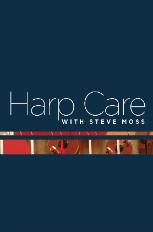
Ouch!
It happens to every harp sooner or later. You do your best to be careful when you move. You load your harp in the car with care. You ask the violists nicely for the thousandth time not to push their chairs into your harp. But no matter how hard you try, the time will come when someone knocks a music stand against your soundboard, or you drop a tuning key, or that overly helpful stage hand runs the top of your column into a doorway. The result. A dent! A ding! A scratch! What are you supposed to do now?
The good news is a small area of damage does not necessarily require complete refinishing to fix. It is possible to touch up a scratch or dent, making it virtually invisible.
Don’t Try this at Home

Making dings like these disappear is better left to a professional.
There are finish touch up products available at your local hardware store, such as touch up pens and wax pencils, but my advice is not to use them. It is difficult to make a good repair, and easy to make the situation worse than it was before you tried to fix it.
If you really want to make a dent or ding invisible, your best bet is to seek professional help. You’ll want to find a musical instrument or furniture touch up artist in your area. An expert in touch ups will know the best way to deal with the damage on your harp and how to match the color of its finish.
Talk to Piano Technicians
The best place to look for recommendations for touch up work is to contact piano technicians in your area. A lot of them do touch up work on pianos and would be well-qualified to do the same for your harp. If they don’t do the work themselves, they will probably be able to recommend someone to you. You can do the same with guitar repair shops. They may also do touch up work or refer to a local expert.
You can also search your area for furniture touch up services, but the reason I recommend going through piano and guitar technicians is that they may know of someone with experience working on musical instruments and will know the proper steps necessary to protect your harp’s strings and mechanical parts from overspray. To find qualified a piano technician in your area, try the search tool at the Piano Technicians Guild website.
Know Your Finish

A pro touch up artist can fill a dent like this with special equipment and make it flush with the rest of the surface.
If you talk to a touch up expert, it will be helpful to know something about the finish on your harp. A large number of harp makers, including Lyon & Healy and Venus harps, use a lacquer finish. This finish is a standard in the furniture industry and is well-known to people who do touch up work. Salvi and Camac instruments have a polyurethane finish. This is a more durable coating, but it is harder for a touch up expert to work with, and not all will be willing to help you. Whatever make of harp you have, I would recommend contacting the maker to ask what finish was used on the harp. There are multiple types of lacquer as well, including precatalyzed lacquer, so the more you know, the better informed your touch up artist will be.
So don’t just live with that unsightly dent. Good touch up artists can be quite affordable. In many cases they’ll even come to your house. Your harp will thank you.


0 Comments